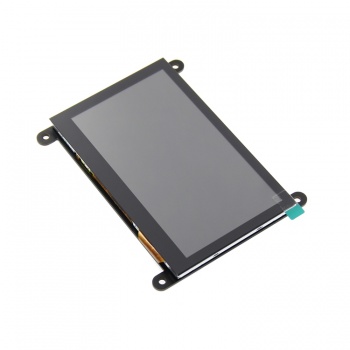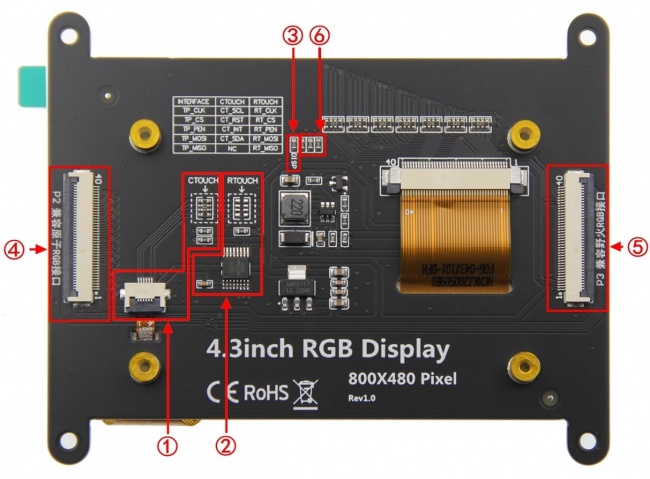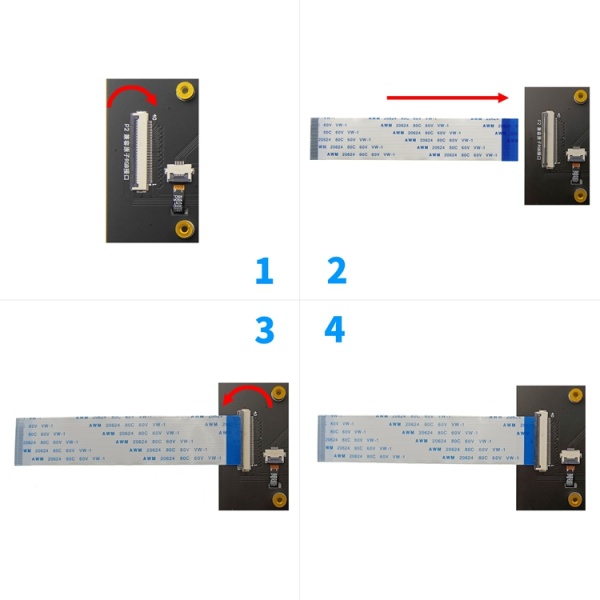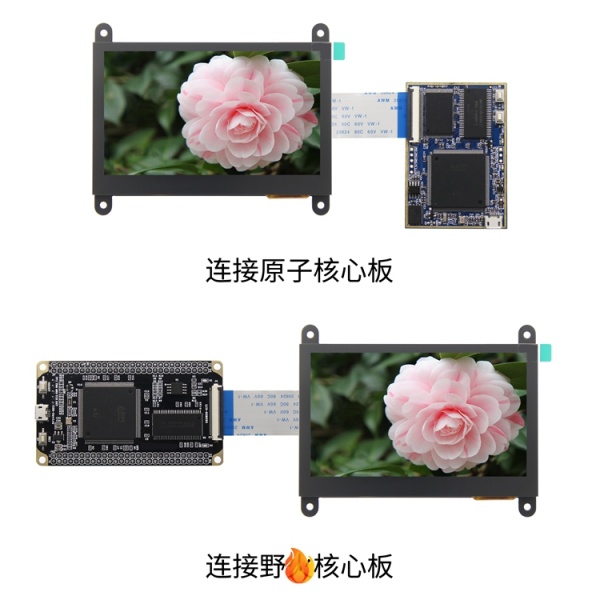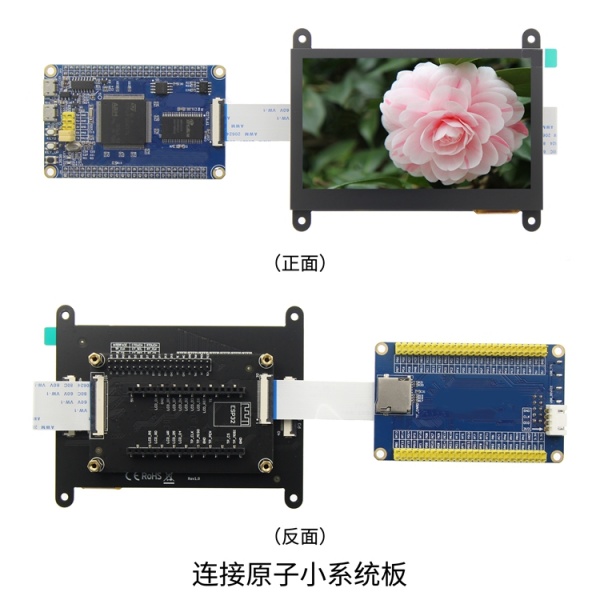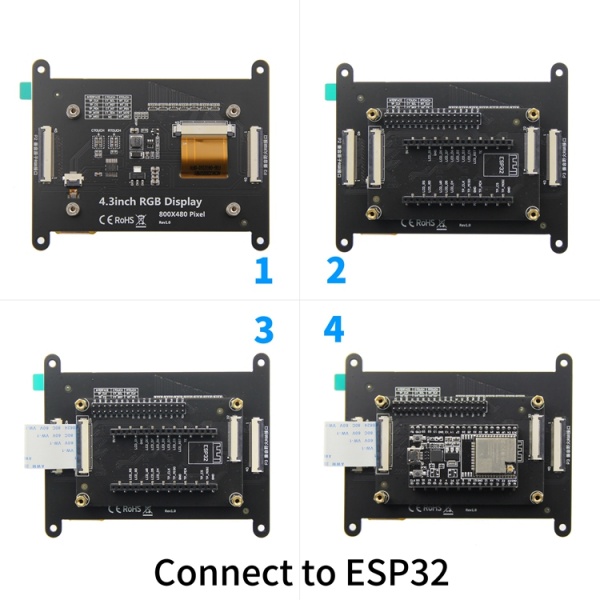More actions
No edit summary |
|||
| (35 intermediate revisions by 2 users not shown) | |||
| Line 1: | Line 1: | ||
4.3inch_RGB_Display | {{lan | ||
| | |||
cn=http://www.lcdwiki.com/zh/4.3inch_RGB_Display | |||
| | |||
en=http://www.lcdwiki.com/4.3inch_RGB_Display | |||
}} | |||
== <font color="blue">Product Picture</font> == | |||
[[File:4.3-RGB-3.jpg|350px]] [[File:4.3-RGB-2pin-修改丝印.jpg|350px]][[File:4.3-RGB-连接.jpg|350px]] | |||
==<font color="blue">Product Description</font> == | |||
* 4.3-inch color screen, support 24BIT RGB 16.7M color display, display rich colors | |||
* Support 800x480, the display effect is very clear | |||
* Support 24 bit RGB parallel bus transmission | |||
* Compatible with RGB interface connection of punctual atomic development board and wildfire development board | |||
* It supports the switching between capacitive touch screen and resistance touch screen, and the capacitive touch screen can support up to 5 touch points | |||
* Provides a rich sample program for STM32 platforms | |||
* Military-grade process standards, long-term stable work | |||
* Provide underlying driver technical support | |||
==<font color="blue">Product Parameters</font> == | |||
{| class="wikitable" border="1" style="width: 650px; background-color: white;" | |||
| align="center" |Name | |||
| align="center" |Parameter | |||
|- | |||
| align="center" |Display Color | |||
| align="center" |RGB888 16.7M (compatible with rgb5665k) color | |||
|- | |||
| align="center" |SKU | |||
| align="center" |MRG4301(no touch), MRG4311(have touch) | |||
|- | |||
| align="center" |Screen Size | |||
| align="center" |4.3(inch) | |||
|- | |||
| align="center" |Type | |||
| align="center" |TFT | |||
|- | |||
| align="center" |Driver IC | |||
| align="center" |None | |||
|- | |||
| align="center" |Resolution | |||
| align="center" |800*480 (Pixel) | |||
|- | |||
| align="center" |Module Interface | |||
| align="center" |24Bit RGB parallel interface | |||
|- | |||
| align="center" |Touch Screen Type | |||
| align="center" |Capacitive or Resistive touch screen | |||
|- | |||
| align="center" |Touch IC | |||
| align="center" |FT5426(Capacitive touch), XPT2046(Resistive touch) | |||
|- | |||
| align="center" |Active Area | |||
| align="center" |95.04x53.86(mm) | |||
|- | |||
| align="center" |Module PCB Size | |||
| align="center" |105.41x86.41(mm) | |||
|- | |||
| align="center" |Operating Temperature | |||
| align="center" | -10℃~60℃ | |||
|- | |||
| align="center" |Storage Temperature | |||
| align="center" | -20℃~70℃ | |||
|- | |||
| align="center" |Input Voltage | |||
| align="center" |5V | |||
|- | |||
| align="center" |IO Voltage | |||
| align="center" |3.3V | |||
|- | |||
| align="center" |Power Consumption | |||
| align="center" |50mA(The backlight is off), 165mA(The backlight is the brightest) | |||
|- | |||
| align="center" |Rough Weight(Net weight) | |||
| align="center" |95(g) | |||
|} | |||
==<font color="blue">Interface Definition</font> == | |||
[[File:MRG4311_006.jpg|650px]] | |||
:①--Capacitive touch screen circuit | |||
:②--Resistance touch screen circuit | |||
:③--Disp resistance | |||
:④--P2 interface (compatible with atomic RGB interface) | |||
:⑤--P3 interface (compatible with wildfire RGB interface) | |||
:⑥--Module ID defines resistance (only for atomic program) | |||
'''1. Switch touch screen''' | |||
:If you choose to connect the capacitive touch screen, please weld the capacitor touch screen circuit; | |||
:Select the connection resistance touch screen, please weld the resistance touch screen circuit; | |||
:If you often need to switch the touch screen, after welding other circuits, only switch the drain | |||
:resistance in the dotted line box; | |||
'''2. Precautions for disp resistance welding''' | |||
:When connecting the wildfire development board for use, the disp resistance must be removed, otherwise | |||
:the screen will not display after the development board is reset; | |||
:'''When connected to wildfire i When using the MX6ULL ARM Linux development board, you need to remove''' | |||
:'''the DISP resistor and the three resistors in parallel, otherwise the development board will not run.''' | |||
:When connecting atomic development board, f407 minimum system board or esp32 development board, disp | |||
:resistance must be welded, otherwise the screen will not be displayed. | |||
'''3. P2 and P3 interface pins are described as follows:''' | |||
*'''P2 interface (compatible with atomic RGB interface) pin description''' | |||
{| class="wikitable" border="1" style="width: 700px; background-color: white;" | |||
|- | |||
| align="center" |Number | |||
| align="center" |Pin name | |||
| align="center" |Description | |||
|- | |||
| align="center" |1 | |||
| align="center" |VCC5 | |||
|Power input pin(connect to 5V) | |||
|- | |||
| align="center" |2 | |||
| align="center" |VCC5 | |||
|Power input pin(connect to 5V) | |||
|- | |||
| align="center" |3~10 | |||
| align="center" |R0~R7 | |||
|8-bit RED data pin | |||
|- | |||
| align="center" |11 | |||
| align="center" |GND | |||
|power ground pin | |||
|- | |||
| align="center" |12~19 | |||
| align="center" |G0 ~ G7 | |||
|8-bit GREEN data pin | |||
|- | |||
| align="center" |20 | |||
| align="center" |GND | |||
|power ground pin | |||
|- | |||
| align="center" |21~28 | |||
| align="center" |B0 ~ B7 | |||
|8-bit GREEN data pin | |||
|- | |||
| align="center" |29 | |||
| align="center" |GND | |||
|power ground pin | |||
|- | |||
| align="center" |30 | |||
| align="center" |PCLK | |||
|Pixel clock control pin | |||
|- | |||
| align="center" |31 | |||
| align="center" |VSYNC | |||
|Vertical synchronous signal control pin | |||
|- | |||
| align="center" |32 | |||
| align="center" |HSYNC | |||
|Horizontal synchronous signal control pin | |||
|- | |||
| align="center" |33 | |||
| align="center" |DE | |||
|Data enable signal control pin | |||
|- | |||
| align="center" |34 | |||
| align="center" |BL | |||
|LCD backlight control pin | |||
|- | |||
| align="center" |35 | |||
| align="center" |TP_CS | |||
|Capacitor touch screen reset pin (resistance touch screen chip selection pin) | |||
|- | |||
| align="center" |36 | |||
| align="center" |TP_MOSI | |||
|Data pin of IIC bus of capacitance touch screen (write data pin of SPI bus of resistance touch screen) | |||
|- | |||
| align="center" |37 | |||
| align="center" |TP_MISO | |||
|Resistance touch screen SPI bus read data pin (capacitance touch screen not used) | |||
|- | |||
| align="center" |38 | |||
| align="center" |TP_CLK | |||
|IIC bus clock control pin of capacitive touch screen (SPI bus clock control pin of resistance touch screen) | |||
|- | |||
| align="center" |39 | |||
| align="center" |TP_PEN | |||
|Touch screen interrupt control pin (low level when touch is generated) | |||
|- | |||
| align="center" |40 | |||
| align="center" |RST | |||
|LCD reset control pin (effective at low level) | |||
|- | |||
|} | |||
*'''P3 interface (compatible with wildfire RGB interface) pin description''' | |||
{| class="wikitable" border="1" style="width: 700px; background-color: white;" | |||
|- | |||
| align="center" |Number | |||
| align="center" |Pin name | |||
| align="center" |Description | |||
|- | |||
| align="center" |1 | |||
| align="center" |VCC5 | |||
|Power input pin(connect to 5V) | |||
|- | |||
| align="center" |2 | |||
| align="center" |VCC5 | |||
|Power input pin(connect to 5V) | |||
|- | |||
| align="center" |3 | |||
| align="center" |VCC3.3 | |||
|Power input pin(connect to 3.3V) | |||
|- | |||
| align="center" |4 | |||
| align="center" |VCC3.3 | |||
|Power input pin(connect to 3.3V) | |||
|- | |||
| align="center" |5 | |||
| align="center" |GND | |||
|power ground pin | |||
|- | |||
| align="center" |6~13 | |||
| align="center" |R0 ~ R7 | |||
|8-bit RED data pin | |||
|- | |||
| align="center" |14~21 | |||
| align="center" |G0 ~ G7 | |||
|8-bit GREEN data pin | |||
|- | |||
| align="center" |22~29 | |||
| align="center" |B0 ~ B7 | |||
|8-bit BLUE data pin | |||
|- | |||
| align="center" |30 | |||
| align="center" |PCLK | |||
|Pixel clock control pin | |||
|- | |||
| align="center" |31 | |||
| align="center" |HSYNC | |||
|Horizontal synchronous signal control pin | |||
|- | |||
| align="center" |32 | |||
| align="center" |VSYNC | |||
|Vertical synchronous signal control pin | |||
|- | |||
| align="center" |33 | |||
| align="center" |DE | |||
|Data enable signal control pin | |||
|- | |||
| align="center" |34 | |||
| align="center" |DISP | |||
|LCD display enable pin (enable at high level) | |||
|- | |||
| align="center" |35 | |||
| align="center" |BL | |||
|LCD backlight control pin | |||
|- | |||
| align="center" |36 | |||
| align="center" |GND | |||
|power ground pin | |||
|- | |||
| align="center" |37 | |||
| align="center" |TP_RST | |||
|Capacitor touch screen reset pin(enable at low level) | |||
|- | |||
| align="center" |38 | |||
| align="center" |TP_PEN | |||
|Touch screen interrupt control pin (low level when touch is generated) | |||
|- | |||
| align="center" |39 | |||
| align="center" |TP_SDA | |||
|Data pin of IIC bus of capacitance touch screen | |||
|- | |||
| align="center" |40 | |||
| align="center" |TP_SCL | |||
|IIC bus clock control pin of capacitive touch screen | |||
|- | |||
|} | |||
==<font color="blue">How to connect the development board</font> == | |||
[[File:5-RGB-连接-40pin.jpg|600px]] <br> | |||
[[File:4.3-RGB-连接.jpg|600px]] <br> | |||
[[File:4.3-RGB-转接板-原子小系统板.jpg|600px]] <br> | |||
[[File:4.3-RGB-STM32F407-1.jpg|600px]] <br> | |||
[[File:4.3-RGB-ESP32-5.jpg|600px]] <br> | |||
==<font color="blue">Program Download</font> == | |||
* [http://www.lcdwiki.com/res/Program/RGB_LCD/4.3inch/RGB_Display_V1.1/4.3inch_RGB_Display_V1.1.zip '''4.3inch RGB Display Module package'''] | |||
==<font color="blue">Product Documentation</font> == | |||
* [http://www.lcdwiki.com/res/MRG4311/4.3inch_RGB_Display_User_Manual_EN.pdf '''4.3inch RGB Display Module User Manual'''] | |||
* [http://www.lcdwiki.com/res/MRG4311/4.3inch_IPS_043JGI50_Specification.pdf '''4.3inch RGB TFTLCD Specification'''] | |||
* [http://www.lcdwiki.com/res/MRG4311/4.3inch_RGB_Timing_800x480.pdf '''4.3inch RGB TFTLCD RGB Timing'''] | |||
* [http://www.lcdwiki.com/zh/images/5/5e/MRG4311_001.jpg '''4.3inch RGB Display Module Size Picture'''] | |||
* [http://www.lcdwiki.com/res/MRG4311/4.3inch_RGB_Display_Schematic.pdf '''4.3inch RGB Display Module Schematic'''] | |||
* [http://www.lcdwiki.com/res/MRG4311/Altium_Package_Library.zip '''4.3inch RGB Display Module TFTLCD Schematic and PCB Package Library'''] | |||
* [http://www.lcdwiki.com/res/MRG4311/ILI6122_SPEC_V008_20100519.pdf '''4.3inch RGB display driver IC data manual ILI6122'''] | |||
* [http://www.lcdwiki.com/res/MRG4311/FT5x26-Datasheet(V01).pdf '''Capacitance touch IC FT5426 Data sheet'''] | |||
* [http://www.lcdwiki.com/res/MRG4311/Application_Note_for_CTPM_FocalTech.pdf '''Capacitance touch IC FT5426 Programming Guide'''] | |||
* [http://www.lcdwiki.com/res/MRG4311/XPT2046.pdf '''Resistance touch screen control IC XPT2046 Data sheet'''] | |||
==<font color="blue">Reference Materials</font> == | |||
* [http://www.lcdwiki.com/res/PublicFile/STM32_Keil_Use_Illustration_EN.pdf '''STM32 keil software use illustration'''] | |||
* [http://www.lcdwiki.com/res/PublicFile/PCtoLCD2002_Use_Illustration_EN.pdf '''PCtoLCD2002 software use illustration'''] | |||
* [http://www.lcdwiki.com/res/PublicFile/Image2Lcd_Use_Illustration_EN.pdf '''Image2Lcd software use illustration'''] | |||
* [http://www.lcdwiki.com/Chinese_and_English_display_modulo_settings '''Chinese and English display modulo settings'''] | |||
==<font color="blue">Common Software</font> == | |||
* [http://www.lcdwiki.com/res/software/PCtoLCD2002.zip '''PCtoLCD2002'''] | |||
* [http://www.lcdwiki.com/res/software/Image2Lcd.zip '''Image2Lcd'''] | |||
[[#top|BACK TO TOP]] | |||
Latest revision as of 14:19, 26 October 2023
Product Picture
Product Description
- 4.3-inch color screen, support 24BIT RGB 16.7M color display, display rich colors
- Support 800x480, the display effect is very clear
- Support 24 bit RGB parallel bus transmission
- Compatible with RGB interface connection of punctual atomic development board and wildfire development board
- It supports the switching between capacitive touch screen and resistance touch screen, and the capacitive touch screen can support up to 5 touch points
- Provides a rich sample program for STM32 platforms
- Military-grade process standards, long-term stable work
- Provide underlying driver technical support
Product Parameters
| Name | Parameter |
| Display Color | RGB888 16.7M (compatible with rgb5665k) color |
| SKU | MRG4301(no touch), MRG4311(have touch) |
| Screen Size | 4.3(inch) |
| Type | TFT |
| Driver IC | None |
| Resolution | 800*480 (Pixel) |
| Module Interface | 24Bit RGB parallel interface |
| Touch Screen Type | Capacitive or Resistive touch screen |
| Touch IC | FT5426(Capacitive touch), XPT2046(Resistive touch) |
| Active Area | 95.04x53.86(mm) |
| Module PCB Size | 105.41x86.41(mm) |
| Operating Temperature | -10℃~60℃ |
| Storage Temperature | -20℃~70℃ |
| Input Voltage | 5V |
| IO Voltage | 3.3V |
| Power Consumption | 50mA(The backlight is off), 165mA(The backlight is the brightest) |
| Rough Weight(Net weight) | 95(g) |
Interface Definition
- ①--Capacitive touch screen circuit
- ②--Resistance touch screen circuit
- ③--Disp resistance
- ④--P2 interface (compatible with atomic RGB interface)
- ⑤--P3 interface (compatible with wildfire RGB interface)
- ⑥--Module ID defines resistance (only for atomic program)
1. Switch touch screen
- If you choose to connect the capacitive touch screen, please weld the capacitor touch screen circuit;
- Select the connection resistance touch screen, please weld the resistance touch screen circuit;
- If you often need to switch the touch screen, after welding other circuits, only switch the drain
- resistance in the dotted line box;
2. Precautions for disp resistance welding
- When connecting the wildfire development board for use, the disp resistance must be removed, otherwise
- the screen will not display after the development board is reset;
- When connected to wildfire i When using the MX6ULL ARM Linux development board, you need to remove
- the DISP resistor and the three resistors in parallel, otherwise the development board will not run.
- When connecting atomic development board, f407 minimum system board or esp32 development board, disp
- resistance must be welded, otherwise the screen will not be displayed.
3. P2 and P3 interface pins are described as follows:
- P2 interface (compatible with atomic RGB interface) pin description
| Number | Pin name | Description |
| 1 | VCC5 | Power input pin(connect to 5V) |
| 2 | VCC5 | Power input pin(connect to 5V) |
| 3~10 | R0~R7 | 8-bit RED data pin |
| 11 | GND | power ground pin |
| 12~19 | G0 ~ G7 | 8-bit GREEN data pin |
| 20 | GND | power ground pin |
| 21~28 | B0 ~ B7 | 8-bit GREEN data pin |
| 29 | GND | power ground pin |
| 30 | PCLK | Pixel clock control pin |
| 31 | VSYNC | Vertical synchronous signal control pin |
| 32 | HSYNC | Horizontal synchronous signal control pin |
| 33 | DE | Data enable signal control pin |
| 34 | BL | LCD backlight control pin |
| 35 | TP_CS | Capacitor touch screen reset pin (resistance touch screen chip selection pin) |
| 36 | TP_MOSI | Data pin of IIC bus of capacitance touch screen (write data pin of SPI bus of resistance touch screen) |
| 37 | TP_MISO | Resistance touch screen SPI bus read data pin (capacitance touch screen not used) |
| 38 | TP_CLK | IIC bus clock control pin of capacitive touch screen (SPI bus clock control pin of resistance touch screen) |
| 39 | TP_PEN | Touch screen interrupt control pin (low level when touch is generated) |
| 40 | RST | LCD reset control pin (effective at low level) |
- P3 interface (compatible with wildfire RGB interface) pin description
| Number | Pin name | Description |
| 1 | VCC5 | Power input pin(connect to 5V) |
| 2 | VCC5 | Power input pin(connect to 5V) |
| 3 | VCC3.3 | Power input pin(connect to 3.3V) |
| 4 | VCC3.3 | Power input pin(connect to 3.3V) |
| 5 | GND | power ground pin |
| 6~13 | R0 ~ R7 | 8-bit RED data pin |
| 14~21 | G0 ~ G7 | 8-bit GREEN data pin |
| 22~29 | B0 ~ B7 | 8-bit BLUE data pin |
| 30 | PCLK | Pixel clock control pin |
| 31 | HSYNC | Horizontal synchronous signal control pin |
| 32 | VSYNC | Vertical synchronous signal control pin |
| 33 | DE | Data enable signal control pin |
| 34 | DISP | LCD display enable pin (enable at high level) |
| 35 | BL | LCD backlight control pin |
| 36 | GND | power ground pin |
| 37 | TP_RST | Capacitor touch screen reset pin(enable at low level) |
| 38 | TP_PEN | Touch screen interrupt control pin (low level when touch is generated) |
| 39 | TP_SDA | Data pin of IIC bus of capacitance touch screen |
| 40 | TP_SCL | IIC bus clock control pin of capacitive touch screen |
How to connect the development board
Program Download
Product Documentation
- 4.3inch RGB Display Module User Manual
- 4.3inch RGB TFTLCD Specification
- 4.3inch RGB TFTLCD RGB Timing
- 4.3inch RGB Display Module Size Picture
- 4.3inch RGB Display Module Schematic
- 4.3inch RGB Display Module TFTLCD Schematic and PCB Package Library
- 4.3inch RGB display driver IC data manual ILI6122
- Capacitance touch IC FT5426 Data sheet
- Capacitance touch IC FT5426 Programming Guide
- Resistance touch screen control IC XPT2046 Data sheet
Reference Materials
- STM32 keil software use illustration
- PCtoLCD2002 software use illustration
- Image2Lcd software use illustration
- Chinese and English display modulo settings

